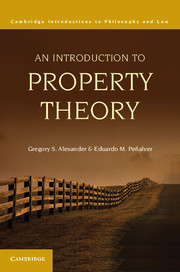9 - Intellectual Property
Published online by Cambridge University Press: 05 June 2012
Summary
INTRODUCTION
In the academic world, the law of intellectual property and tangible property are two separate fields that frequently fail to engage with one another. But the theories that have been used to justify ownership of tangible property apply without too much difficulty to the ownership of ideas. Indeed, the ease of discussing intellectual property using several of the theories we have been exploring in this book suggests that the legal protection of at least some intellectual property is normatively sound. As we will discuss in this chapter, however, the main theories of property suggest that rights of intellectual property, like those of tangible property, must be highly qualified in order to accommodate the many competing values they implicate. Given the massive breadth of this topic, we can barely scratch the surface. Our principal focus in this chapter will be on the domains of copyright and patent, though we will make brief references to other forms of intellectual property.
ENCOURAGING INVENTION: UTILITARIAN THEORIES OF INTELLECTUAL PROPERTY
In Chapter 1, we introduced the Tragedy of the Commons and the problem of free riding. Within the commons tragedy, the rational actor model predicts that, if all of its underlying assumptions hold, the inability to exclude people from using a resource leads to its eventual overconsumption and degradation. With regard to free riders, the model predicts that, if rational individuals are unable to capture the full benefits generated by their productive efforts, they will tend to underinvest in production, because they can simply capture some of the benefits of others’ labor without doing the hard work. The result will be levels of productivity that fail to maximize aggregate utility. Of course, as we will discuss in more detail later in this chapter, human motivations are far more complex than either of these simple discussions assumes. But for the moment we will hew closely to the predictions of the rational actor model.
- Type
- Chapter
- Information
- An Introduction to Property Theory , pp. 183 - 203Publisher: Cambridge University PressPrint publication year: 2012

